Regular exercise is one of the keys to being able to lose weight and keep it off forever. The problem is it's hard to know how to structure your workouts to support your weight loss goal.
7 Steps To Building The Perfect Workout Routine
There is so much information on the internet from so many different sources it's impossible to know what to listen to. The following is a pragmatic science based, low frequency, low volume approach that works and is suitable as an introduction to resistance training for the widest possible audience.
This 7 step process is the same process our Expert Exercise Physiologists go through when creating workout programs. Stop wasting time on exercise that doesn't work. Stop looking for your next 30 day squat or ab challenge. Stop spending more time in the gym than you need to. Let's start exercising smart and efficiently!
If you prefer to consume this content in video form click HERE
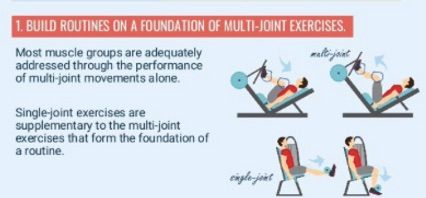
Step 1: Build Your Routine on a Foundation of Multi-Joint Exercises
Resistance exercise is the foundation of your exercise routine. You can get all of the cardiovascular benefits that traditional cardiovascular exercise will give you while burning more calories and building muscle mass which will increase your metabolic rate helping you burn more calories daily. You should always prioritize your resistance training and then add other exercise or physical activity that you enjoy and/or have time for after that. Resistance exercise or "weight lifting"can be intimidating at first but knowing what to do and how to do it when it comes to resistance exercise will give you the confidence you need to start conquering your goals!
What is a multi-joint exercise?
While resistance training is the foundation of your exercise routine, multi-joint exercises are the foundation of your resistance training routine. Studies from world-renowned researchers James Steele and James Fisher have shown that most muscles are adequately addressed through the performance of multi joint exercises alone. This means you can solely focus on these movements and still hit every single muscle group in your body without needing to go back and isolate individual muscles. The research shows that for the appendicular musculature (the muscles of the legs and arms), multi-joint and single-joint exercises produce similar adaptations and results. In other words if a multi-joint exercise involves a particular muscle group there is no need to go over the same ground with a single-joint exercise.
In addition to being able to adequately hit each muscle group through the exclusive use of multi-joint movements you should prioritize these exercises because they burn more calories due to the use of more muscle mass at once. If you're trying to lose weight and keep it off it's important to maximize your daily caloric burn, utilizing multi-joint exercises is the best way to do that. While there are more calories burned during multi-joint exercises they are also more taxing to your central nervous system causing you to feel more fatigued overall than single-joint exercises. For this reason it's best to prioritize multi-joint exercises in your workout so you have as much energy and focus as possible to get the most out of each exercise. Once you've performed the multi-joint exercises you can then go back and perform some single-joint exercises as you see fit but remember according to the research there may not be much if any benefit to doing this.
What Multi-joint exercises should you perform?
It's best to start with a set of 6 core multi-joint movements:
- An upper body vertical pushing movement (Shoulder Press)
- An upper body vertical pulling movement (Pulldown or Chin-ups)
- An upper body horizontal pushing movement (Chest Press or Bench Press)
- An upper body horizontal pulling movement (Seated Row)
- A Lower body pushing movement (Leg Press or Squats)
- A lower body pulling movement (Deadlift)
If you were to perform these 6 exercises twice per week consistently in the fashion that is explained in the rest of this article you will be able to increase your muscle mass and decrease your fat while spending less than 1 hour per week exercising. This is truly a minimal dose approach to exercise that will actually get you results. As you become more advanced in your training you may have the desire to add more exercises into your routine but it is imperative that these 6 exercises be the foundation to all resistance training that you engage in. Remember more isn't always better when it comes to resistance exercise not allowing yourself to recover will only hinder your results, resistance training a muscle group more than 3 times per week is not necessary and with this method you will be hitting each muscle group in each workout so 2-3 workouts per week is plenty!
We believe you deserve a coach who is as invested in your health as you are.
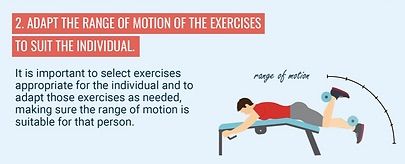
Step 2: Adapt the Range of Motion of the Exercise to Suit Your Individual Ability
Now that you know what exercises that you should be prioritizing in your resistance training workouts lets talk about HOW to actually perform these movements. The first step in performing the exercises is to adapt the range of motion to your individual ability. There are many factors that will determine your range of motion such as past injuries, current flexibility, weight being used, and exercise being performed. It's best to use as much pain free range of motion as possible while being in control of the weight you are using. You can improve your flexibility over time while engaging in resistance exercise if you are using your full range of motion on any given exercise. In addition to being more flexible the more range of motion you use the more movement you are requiring your body to do and therefore the more calories you will burn in your exercise. While range of motion will not determine how much strength or muscle you will build it will certainly change the amount of calories you burn over the course of your workout.
The best way to determine your individual range of motion on an exercise is to start with a very light weight and practice going through the motion and seeing if you have any pain points or limitations even when the weight is light. If you do make note of the point when you're unable to remain in perfect form or when/if there is any pain at any point during the movement. If there is a form breakdown or pain then you should stop the movement just before that point. An example would be if you are performing a squat and you get to a point where your back is starting to arch that means you should stop before going that low in order to remain in perfect form.
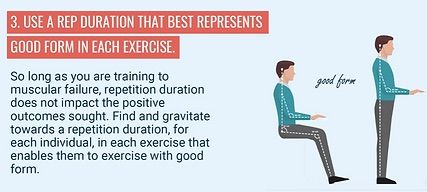
Step 3: Use a Rep Duration That Represents Good Form In Each Exercise
If you walk into any gym you will no doubt witness people throwing weights around with no regard for proper form. Most people think the more reps they do the better or the heavier the weight is the stronger they will get. The reality is that to get the best results we want to fatigue the musculature as much as possible with great form. The most effective way to do this is to eliminate gravity and momentum when you are lifting and lowering the weight. If you eliminate gravity and momentum then it is truly just your muscles lifting and lowering the weight which will produce much great fatigue and much better results.
When it comes to repetition duration researcher James Steele advises that movement should reflect good exercise technique for each exercise. If you move too quickly and your from shows signs of degradation you need to slow down. If you are moving too slowly and the movement becomes a series of segmented stops and starts you should move more quickly. This means each individual rep should take anywhere from 4-30 seconds each. Meaning the pushing/pulling part of the movement takes 2-15 seconds and the lowering phase of the movement also takes 2-15 seconds. Longer repetitions won't give you better results but it will help you stay injury free which should always be your top priority when engaging in resistance exercise. The key is to find a repetition duration for each individual exercise that allows you to exercise with good form and eliminate the effects of momentum and gravity.
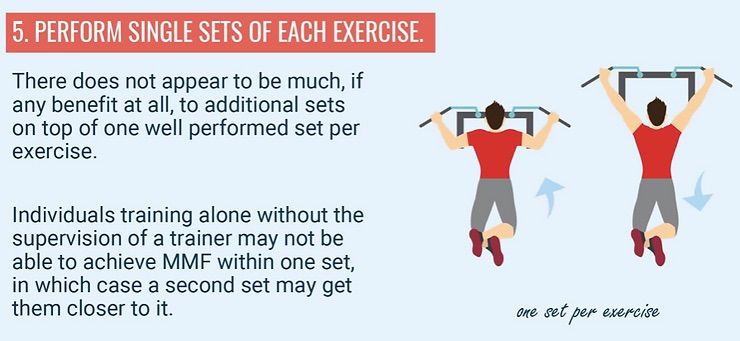
Step 4 & 5: Exercise to a High Intensity of Effort & Perform Single Sets of Each Exercise
Both James Fisher and James Steele recommend using single sets per exercise taken to momentary muscle failure (the point where you are unable to perform another repetition with perfect form) as evidenced in numerous scientific studies on resistance exercise. The results from resistance exercise research is very clear that there is not much if any benefit to performing additional sets of an exercise on top of one well performed set to momentary muscle failure.
The biggest drawback to performing multiple sets of an exercise is the amount of additional time added to the workout. Other than that there is little downside to performing a second or third set but your workouts are going to be much more efficient, enjoyable, and ultimately give you the ability to stay consistent with your new workout routine if you perform each exercise one time with great form and great intensity. If you are unable to reach momentary muscle failure on your own (for example on a squat or barbell bench press) then performing a second set of that exercise might be beneficial to do a second set but you could also substitute that exercise for one that you can reach muscle failure on or use a spotter (preferably a certified exercise professional).
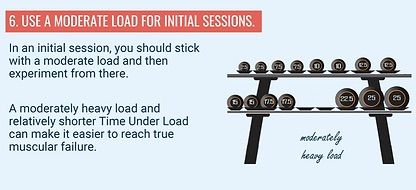
Step 6: Use Moderate Weight for Initial Workouts
There is a common fallacy in resistance training that the amount of weight you use in your workout will determine the type of result you will get. People think that using a lighter weight and performing more repetitions will provide a more "toned" appearance while a heavier weight and less repetitions will provide a more "bulky" appearance. This is a ver flawed outlook on resistance training. The amount of weight lifted has nothing to do with your results, in resistance training results come from the amount of muscle tissue broken down on any given exercise (that's why it's imperative to have high intensity so you can break down as much muscle as possible). If you hit momentary muscle failure with a lighter weight after 20 repetitions versus hitting momentary muscle failure with a heavier weight at 8 repetitions you muscle will have experienced the exact same level of fatigue and therefore get the exact same result. The "toned" or "bulky" appearance will come from your genetic makeup as well as your diet. If you want a toned appearance you simply need to focus on having a lack of fat on top of your muscle not doing more repetitions in your workouts.
The advantage to using a moderate weight when starting a new workout routine is you won't feel intimidated by the weight as you start if the weight is heavy and also the set won't go on for a long duration if the weight is too light. The longer the set the more discomfort you will experience as you try to get to momentary muscle failure. A good target weight that you should select is a weight you can perform the exercise with full range of motion while maintaining good form and where you will reach momentary muscle failure within 1-2 minutes of starting the exercise. Once you have some more experience with the exercises you are performing you can opt to gravitate toward heavier weight or lighter weight depending on your personal preference for each exercise. Just remember the weight lifted DOES NOT determine your results!
Step 7: Perform 2 Resistance Exercise Workouts Per Week
As mentioned earlier in this article recovery is imperative to long term results. When you are engaging in resistance exercise you are actively tearing down you muscle fibers which signals them to repair and when they repair they become stronger than they were before your workout. This is called super compensated, you muscle fibers have fully recovered and now are stronger than they were. This process takes 48 hours of no resistance exercise per muscle group meaning if you exercise the same muscle group before it's fully recovered not only did you allow it to not fully recover and become super compensated but you're also not going to be able to get the most out of your workout which will further hinder your results. If you've followed steps 1-6 but don't allow yourself to adequately recover from your workouts you won't see the results you want. By performing full body workouts it allows you to only have to engage in resistance exercise 2-3 days per week while still getting the best results possible. This is great news because you don't have to waste time in the gym and you can enjoy other forms of physical activity and/or focus on your diet more.
James Fisher points out that when muscle damage has occurred we likely need longer recovery times between workouts to see muscle strength and thickness adaptations. This is especially true if you are new to resistance training because new trainees are more susceptible to muscle damage making training more that twice per week undesirable. Fisher doesn't believe there is any real-world benefit to training a muscle group more than twice a week and pragmatically resistance training needs to fit within the individuals lifestyle. If once per week resistance training is the only practice option this is fine. He does add that once a week workouts will need to be of high quality and probably have a slightly higher volume (more exercises), whereas with more frequent training the amount of exercises per workout can be somewhat reduced.
Summary
There you have it! A template for beginning your new journey in resistance training. Simple, effective, backed by scientific research and recommended by Reformed Fitness. Following this approach to resistance training will allow you to maximize your results and stay consistent with a routine that fits your lifestyle!
For the best results it's best to get a exercise and nutrition plan that is personalized, science based, and easy to consistently execute. If you have questions about this article or anything else exercise or nutrition related click HERE we're always happy to help!
